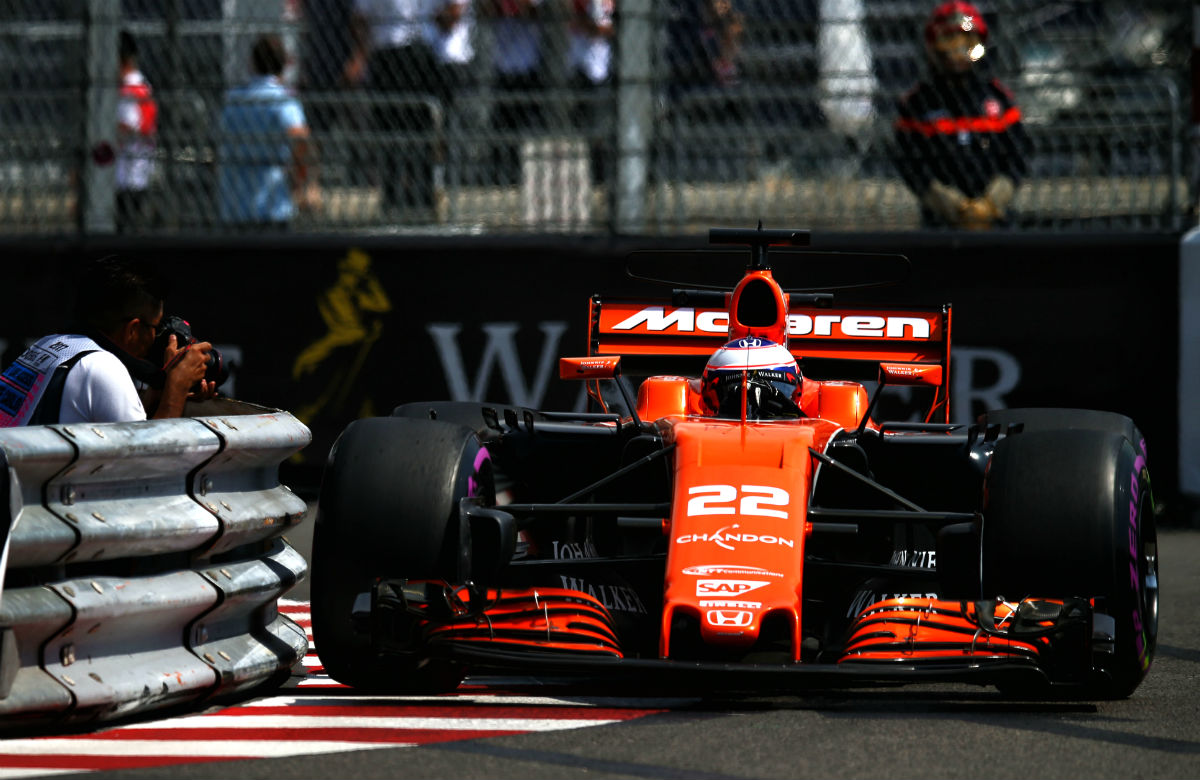The McLaren MCL32 follows in the evolutionary footsteps of its two immediate predecessors, MP4-30 and MP4-31, but it has been overhauled in every area as the engineers at the team have looked to capitalise on the opportunities offered by the new 2017 technical regulations.
Honda has designed and built an all new power unit called the RA617H, HRD F1 LPL Yusuke Hasegawa describes its development. “Based on our two years of acquired experience and constant progress, Honda has made big changes to the concept and layout of our 2017 power unit, the RA617H. The main areas of change that we focused on has been to decrease the weight and lower the centre of gravity, so as to improve the balance of the car, while generating more output from the ICE [internal combustion engine]. Also, owing to the new 2017 regulations fundamentally affecting the design of our new car, Honda has made a lot of changes to accommodate the updated chassis. The team has therefore continued their hard work throughout the winter to find an ideal balance.”

The front wing and nose concept of the MCL32 is fairly similar to that of the MP4-31 but adapted to the new regulations including the wider swept back front wing. Compare the new car (above) with the old (below).

Looking at the front suspension of the MCL32 (below) the arrangement is conventional with pushrod actuated springs. Note also the brake duct design with two air scoops. It is worth noting McLaren has often not fully shown all of the details of its cars at the launch.

The nose on the MCL32 is vented as was the case with the MP4-31, but this time the exit on the top of the nose is not split by an antenna. Note the shape of the parts around the bargeboards.
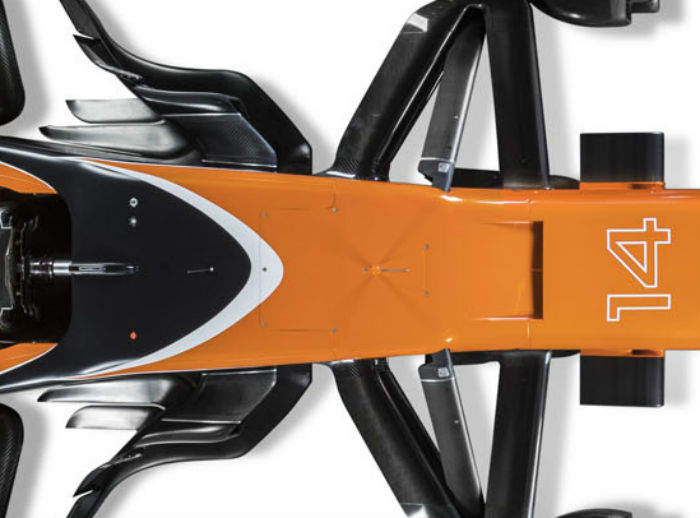
As with all 2017 F1 cars the area behind the front wheel and ahead of the sidepod is extremely complex on the McLaren, with a great number of details on the barge board. Note how it connects to the side of the monocoque at its leading edge.

Cooling is a key factor on the current generation of grand prix car and there are a number of interesting solutions in use on the 2017 grid, and it is likely that under the skin there are some interesting details on the McLaren too.
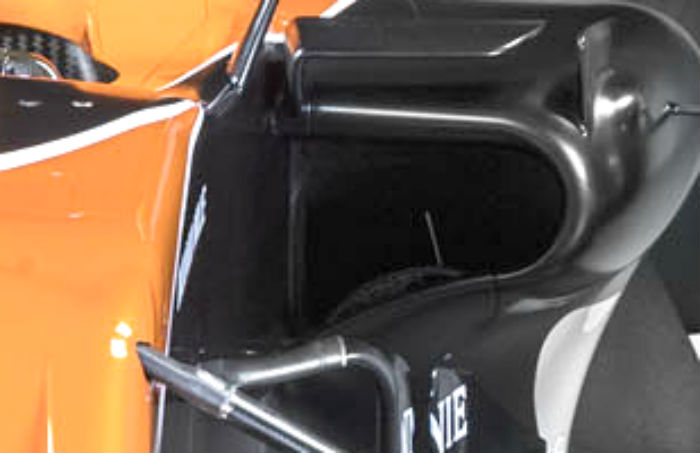
At the launch of the car it was apparent that the two cooling ducts on the sidepods of the car differed from one another slightly. The left hand side duct (above) has a small scoop for cooling components stored under the sidepod duct, as does the right hand side (below), but the scoop is a totally different shape and size.
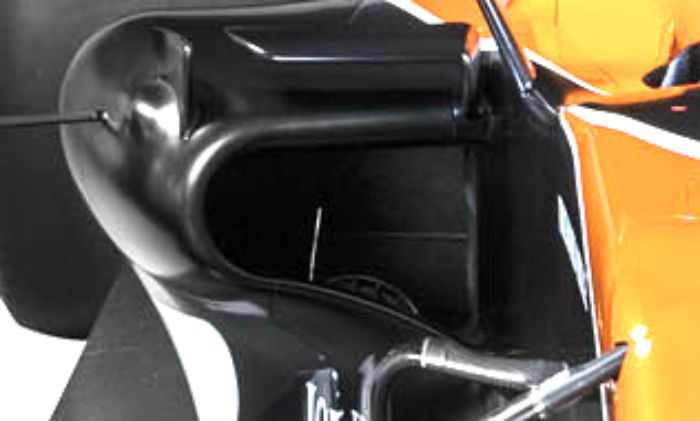
A small bulge on the outer edge of the sidepod is evident on both left and right sides of the car, this sits over the mandatory side impact structure on the car.
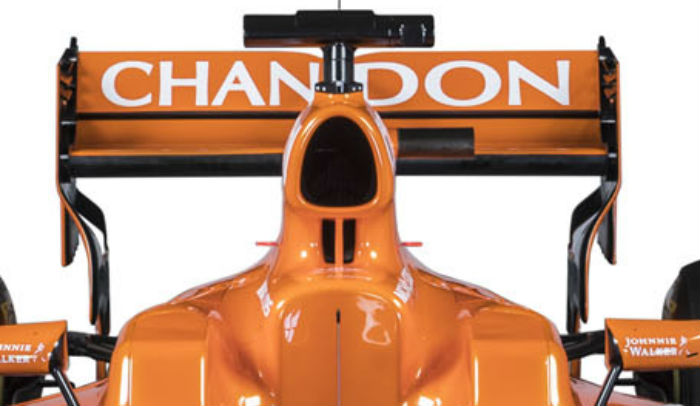
The roll hoop on the MCL32 is fairly conventional and follows the general concept of that used on the MP4-31 with the main duct split between cooling and combustion gas, while a smaller central cooling duct is located below the main duct.
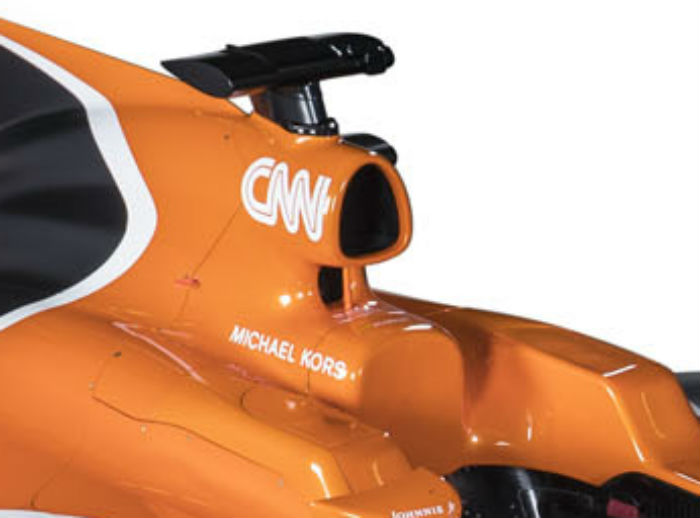
The shape of the intake and the roll hoop as a result has changed notably however while the roll structure itself has once again a single central support. Compare the 2017 version (above) with the 20016 (below) and the differing shapes are easy to see.
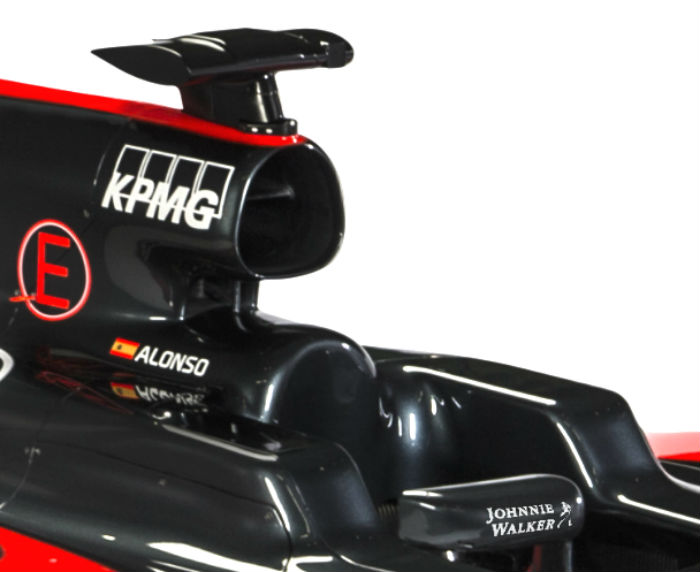
A look at the rear of the MCL32 shows the rear wing mounting, and McLaren seems to have dropped the idea of passing the support through the tailpipe used on the MP4-31, in favour of a more conventional mounting. The pull rod rear suspension layout is visible also.

The rear wing endplate on the MCL32 is extremely complex and features a number of different elements, which will be explored more during pre season testing at Barcelona, note the engine cover fin.
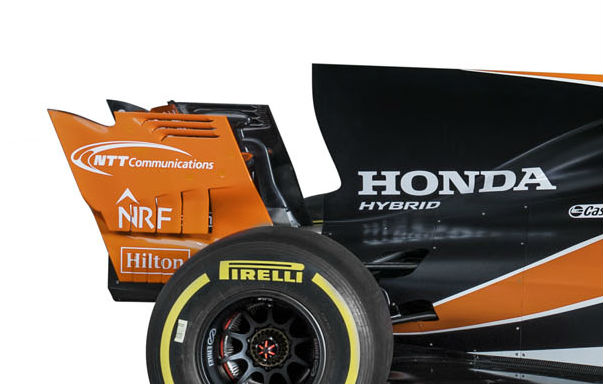
In 2017 the braking systems of every car have changed with larger designs featuring meaning teams are experimenting in this area, not just for braking performance but also aerodynamic gains.
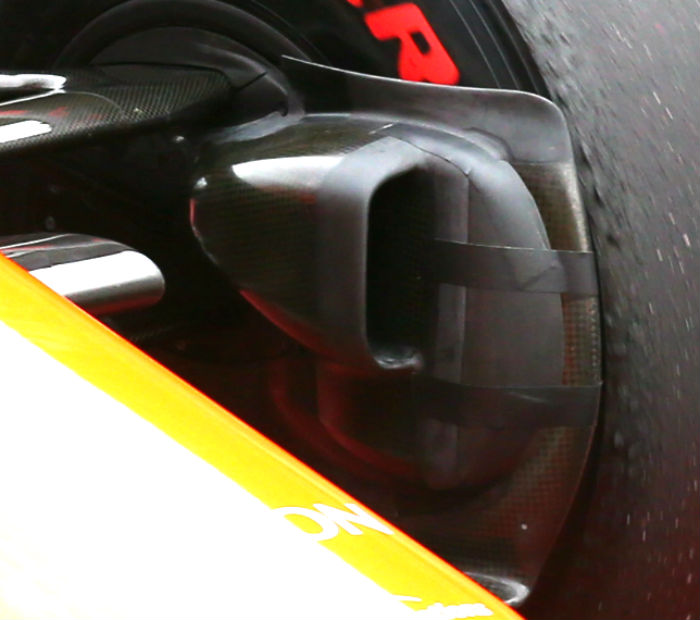
McLaren experimented with the front brake ducts during the first test at Barcelona with the outermost duct completely blanked off (above) but on other runs both were fully open (below)
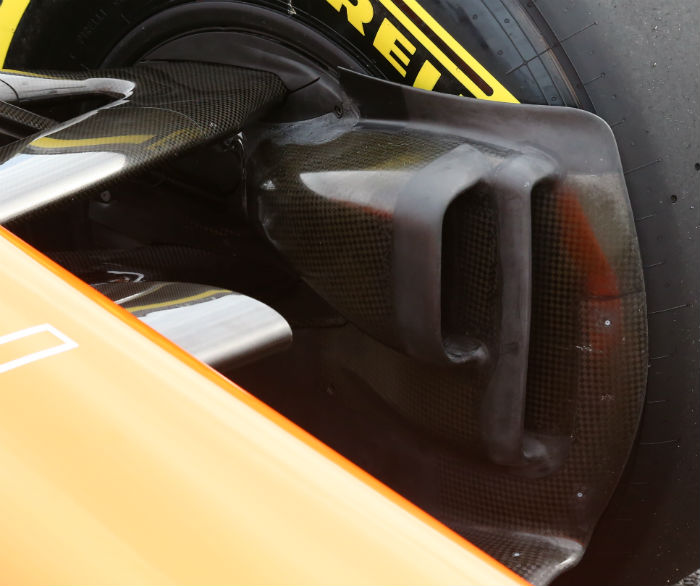
A look (from above) at the rear brake assembly of the MCL32, McLaren uniquely uses Akebono calipers in F1 (below).
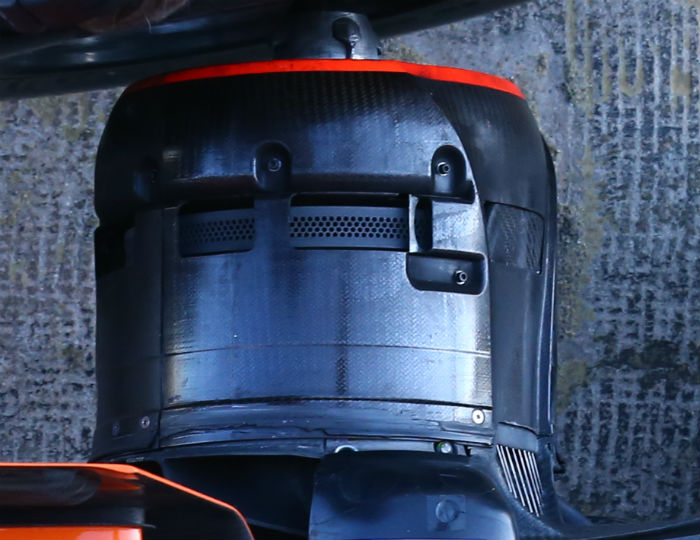
The nose and front wing support of the MCL32 is notable for its outer shape and the slotted drop section, the leading edge of which carries the front wing loads.
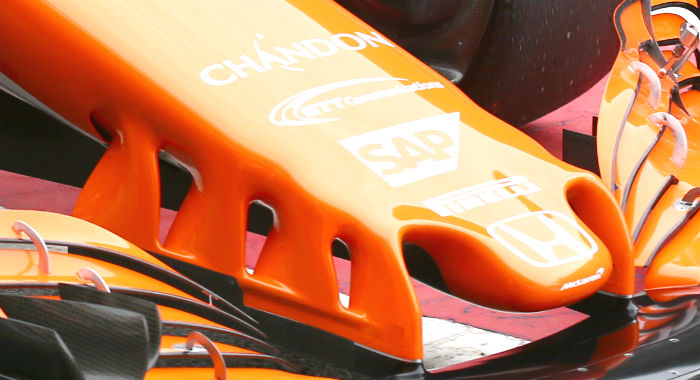
The intake duct for the vented nose is just visible at the trailing edge of the rearmost element of the drop section.
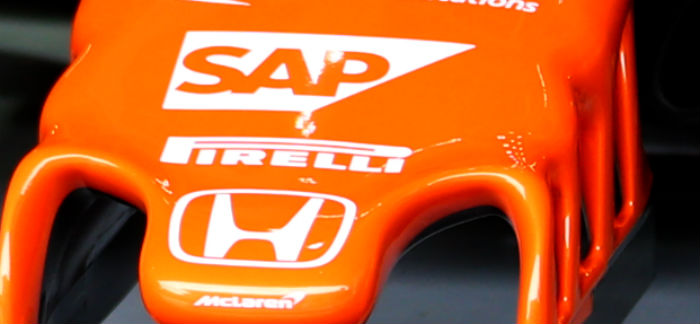
McLaren ran with this semi cylindrical part at the rear of its floor in testing, it is not clear if this is to check the tyres clearance to the floor or if it is an aerodynamic component.
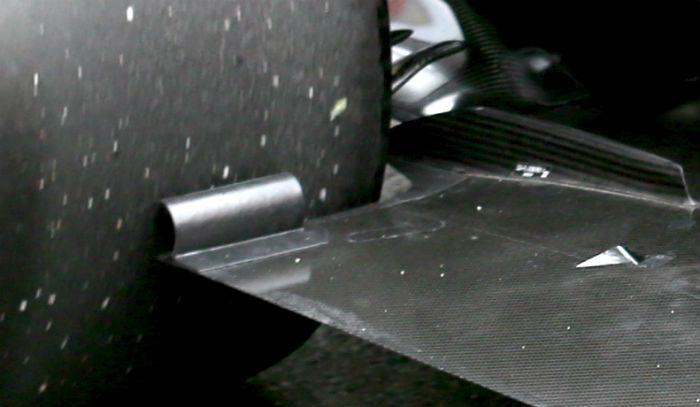
If the latter is correct expect a number of other teams to experiment with similar devices.
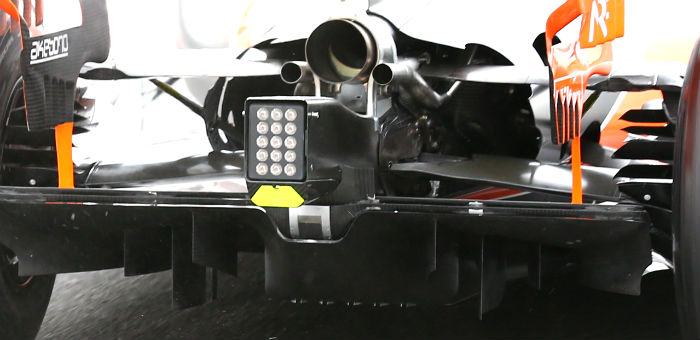
A look the the rear end of the MCL32, note how the wastegate exit pipes drop beneath the upper wishbone. The lower rear wishbone leg is blended and incorporates the driveshaft. (above & below), the McLaren uses a composite transmission casing.
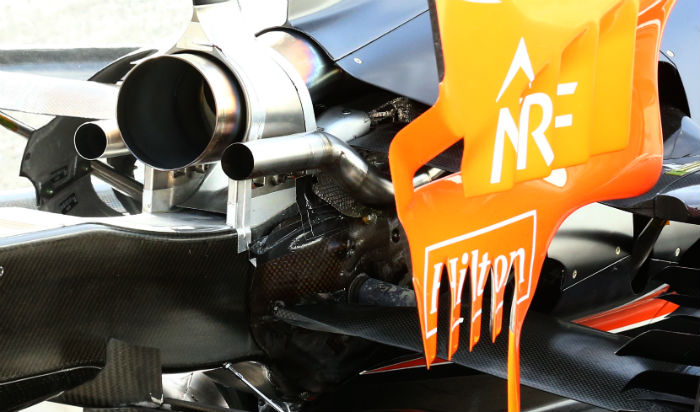
A look at the rear suspension from the front. Its pullrod layout is clear to see.

An additional cooling outlet appeared on the right side of the MCL32 in testing and its impact on the airflow over the sidepod was studied using a pink flow visualisation dye (above and below).
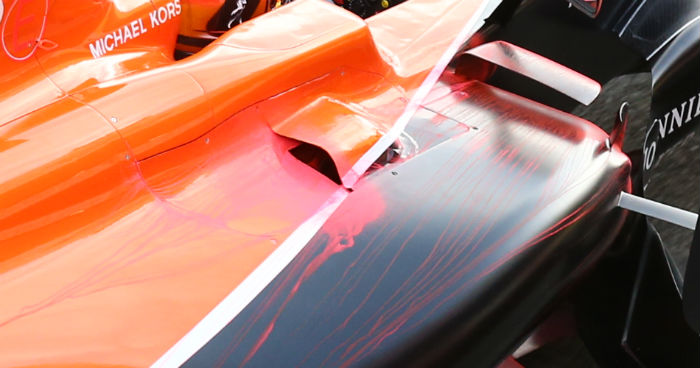
The McLaren MCL32 has struggled throughout 2017 up to the Monaco Grand Prix, leading to speculation about whether the issues lay solely with the power unit.
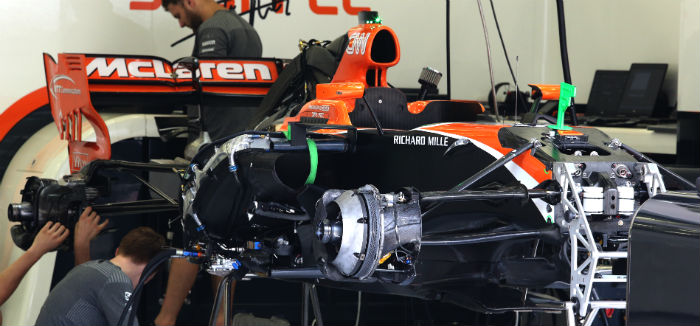 Once the season got underway it became possible to get a look under the bodywork of the MCL32, its general layout is fairly conventional.
Once the season got underway it became possible to get a look under the bodywork of the MCL32, its general layout is fairly conventional.
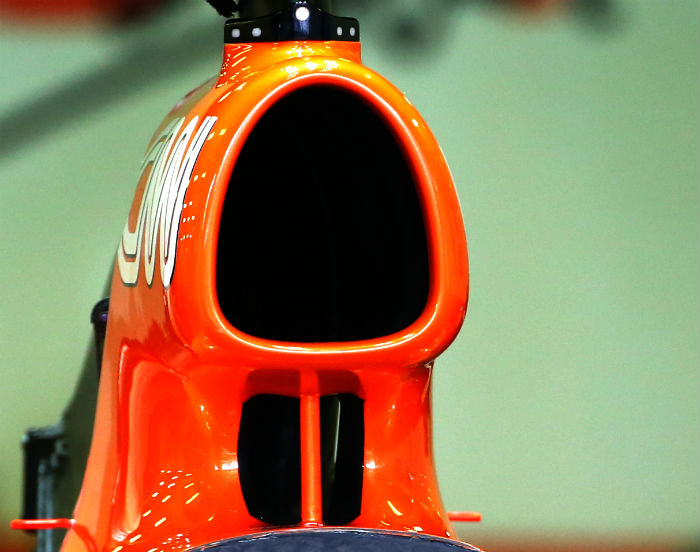
Looking at the roll hoop area of the car it is clear that the main duct is purely for combustion air, while the lower duct is for cooling (it is just possible to see daylight through the lower aperture as the internal ducting is removed).
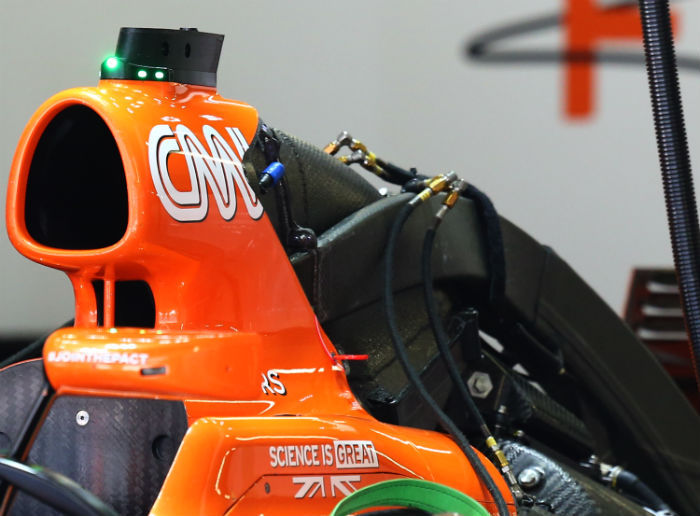
The lower duct feeds a Y shaped duct, one side of which can be seen here. The duct has to be split this way to give the combustion air the best possible path. Downstream of where the cooling duct merges it feeds a heat exchanger mounted above the transmission (below

The MCL32 transmission features a single piece composite casing, seen above and below in a varying state of undress. As a major structural component of the car is has to be substantially stronger than the 2016 version in order to withstand the much higher loads seen in 2017.
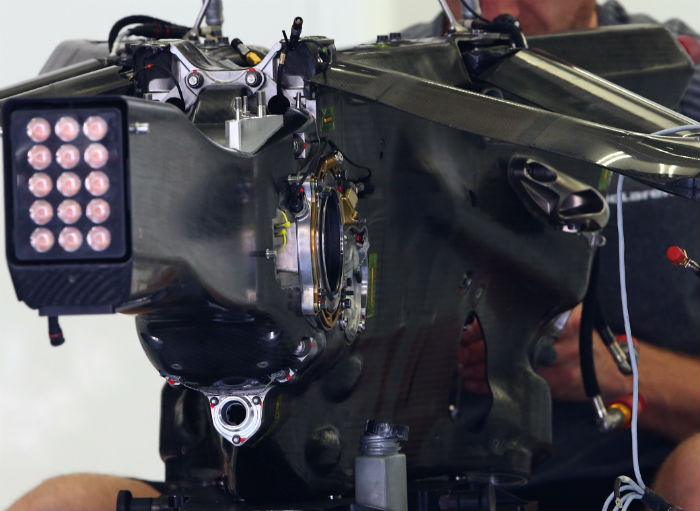
With the car fully built up it is clear to see the major role the transmission casing plays. The turbine of the Honda engine is mounted in the bellhousing area of the car with both the tail pipe and wastegate pipes exiting via the upper part of the casing.
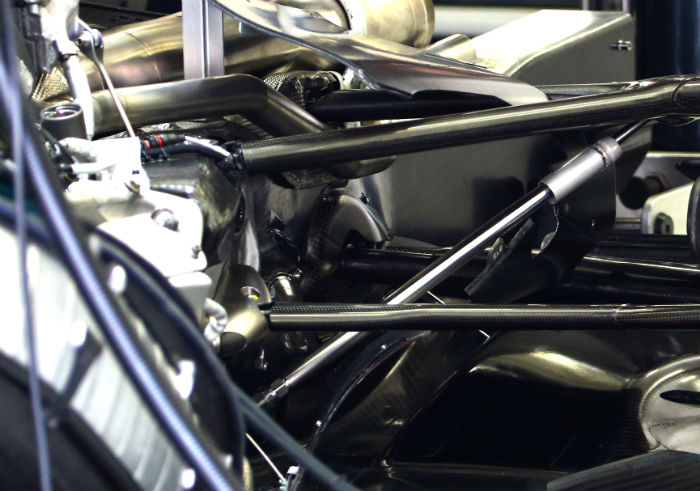
The rear suspension layout is clear to see with the pullrod evident. Interestingly what appears to be the top of one of the torsion bars is visible in this image on the top left next to the wastegate exit and a long way from the pullrod. It will be very interesting to see the full rear suspension layout of the MCL32. Note how the wastegate exit pipe has to curve around the suspension elements.
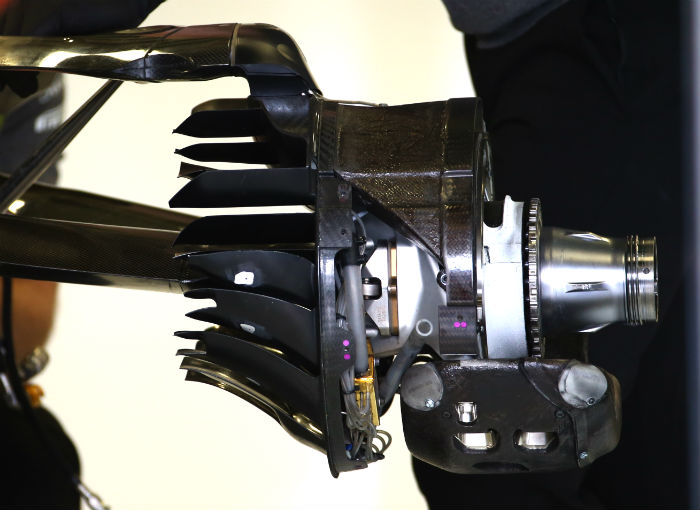 McLaren remains the only team in the F1 paddock to use Akebono brake calipers. Here we can see the rear brake setup with the caliper mounted at the base of the (removed) disc. It has a composite covering. Note the many aerodynamic elements on the inner face of the assembly.
McLaren remains the only team in the F1 paddock to use Akebono brake calipers. Here we can see the rear brake setup with the caliper mounted at the base of the (removed) disc. It has a composite covering. Note the many aerodynamic elements on the inner face of the assembly.
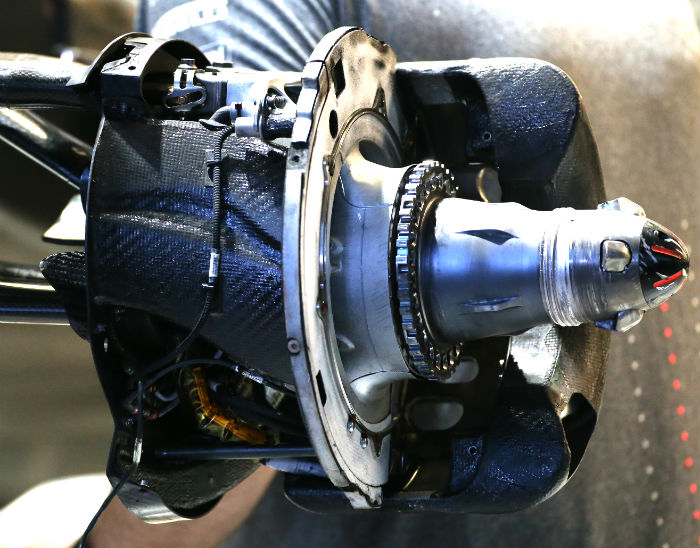
At the front it is a similar story with the caliper again having a composite cover, but in this case it sits at the rear of the (removed) disc. The Japanese company claims to supply not only the brake caliper but also the master cylinder and electro-hydraulic BBW system.
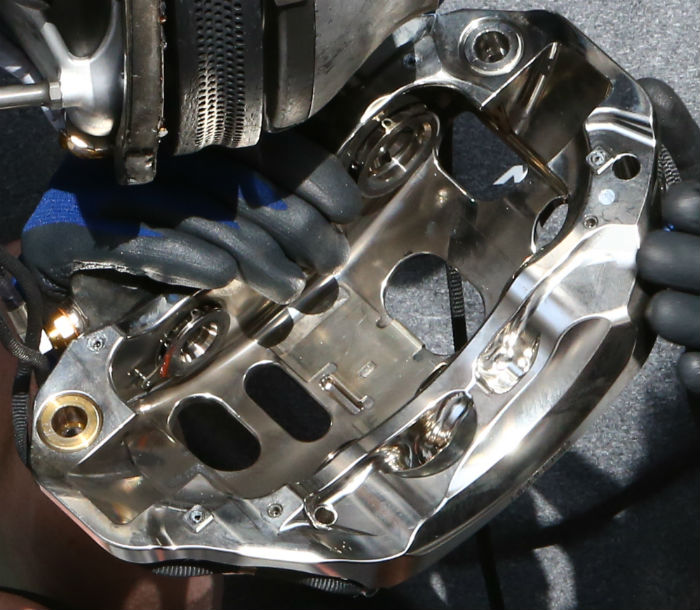
The calipers themselves are made of an aluminium alloy though Akebono declines to reveal much more about them. Looking at this image though it can clearly be seen that the fronts at least are a six piston design.
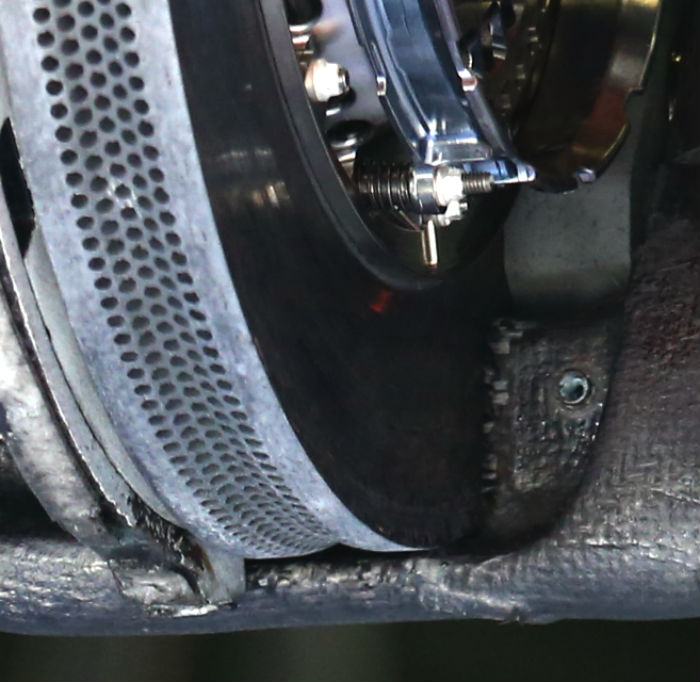
The friction material used by McLaren has not been disclosed but in 2017 it features the discs use the scalloped edges as used by Mercedes in 2017.
A 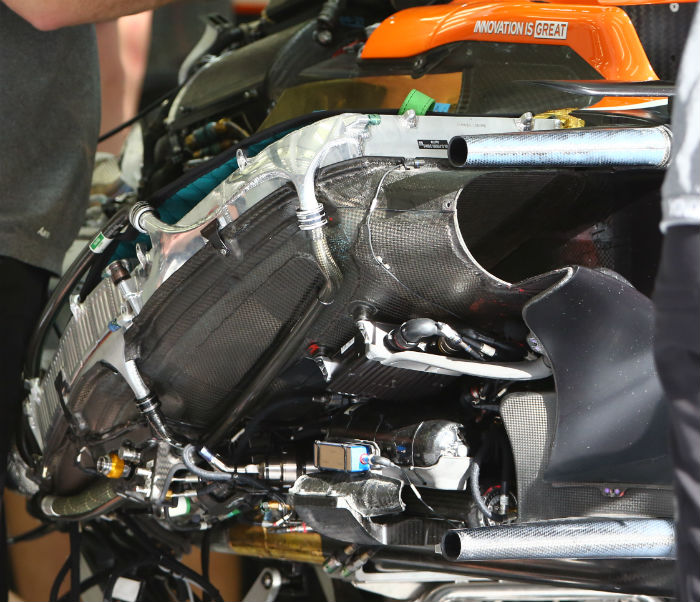 look at the sidepod packaging on the MCL32, note the cooler arrangement as well as the collection of electronic boxes. Note the side impact structures.
look at the sidepod packaging on the MCL32, note the cooler arrangement as well as the collection of electronic boxes. Note the side impact structures.
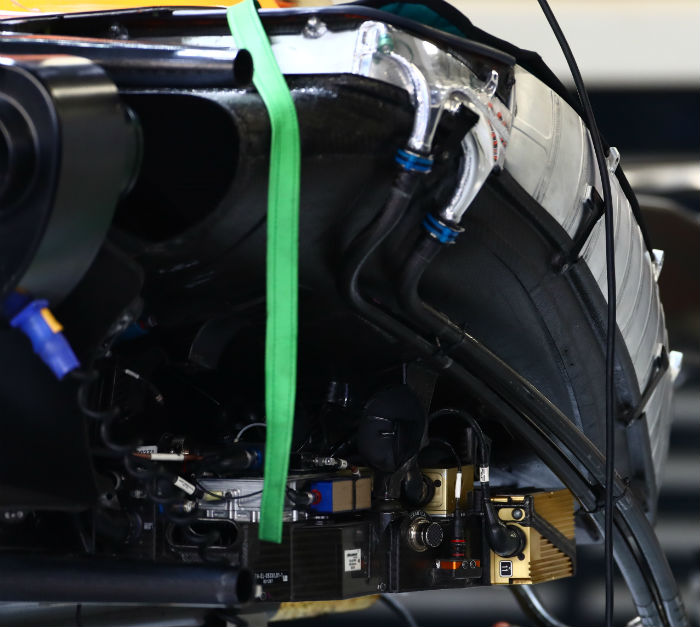
On the opposite side of the car the charge air cooler is visible as well as more electronic boxes.
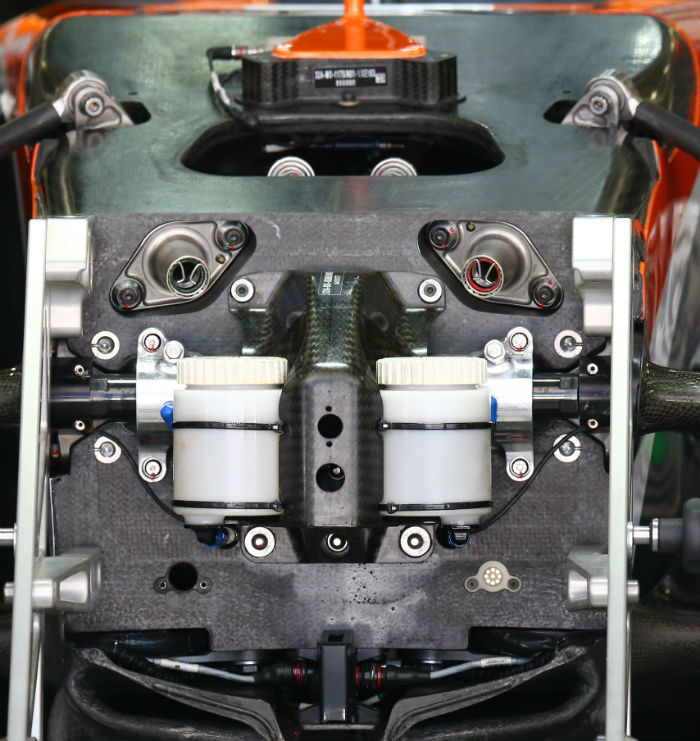
A look at the front bulkhead of the MCL32. The torsion bars are clear to see, with a curious outward angle. The inboard pushrod pickup point reveals the rough location of the far end of the bars.
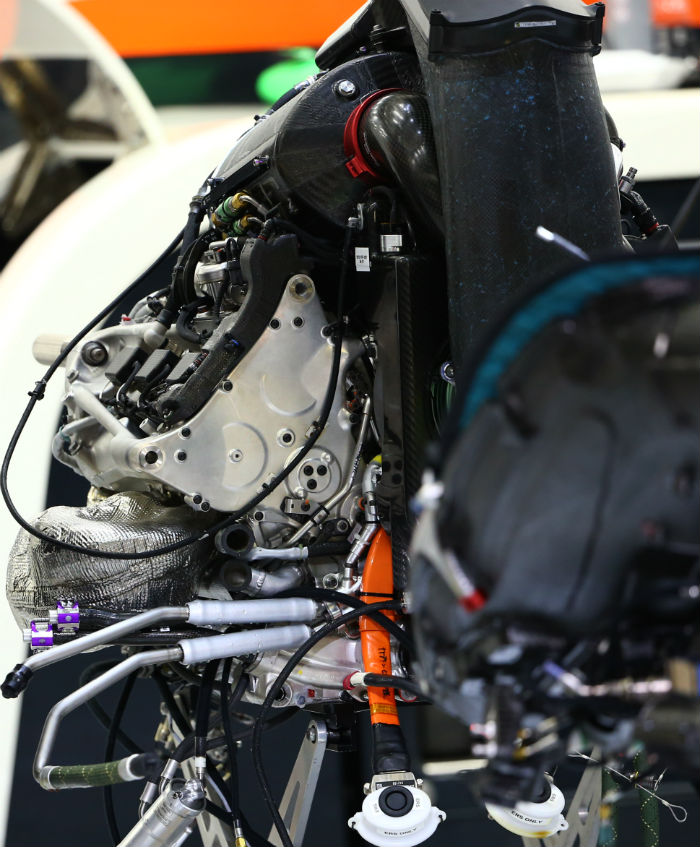
Compare the design of the new RA617H (above) with the RA615H (below) and the amount of difference between the two is very clear to see indeed. There is almost no relationship between the two beyond the cubic capacity and the cylinder bank angle
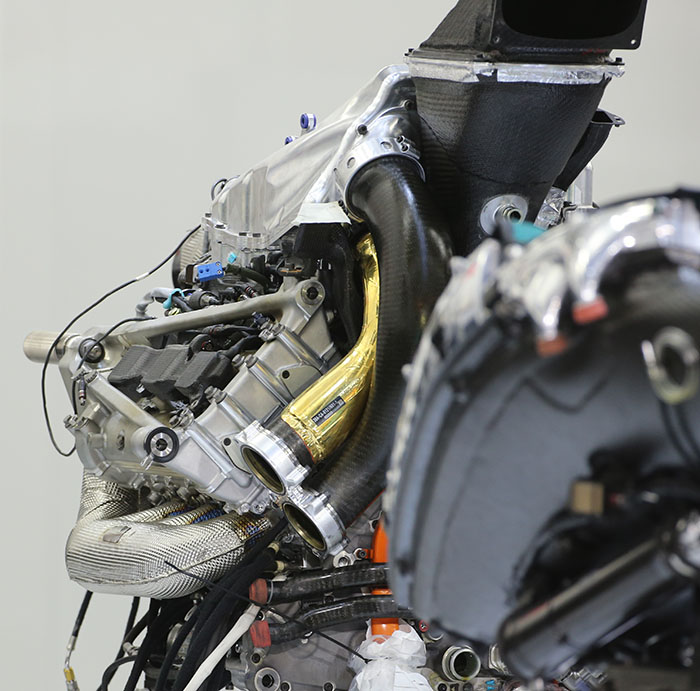
It is now clear that the Honda RA616H’s centre of gravity height was higher than would be ideal. The F1 technical regulations give a minimum power unit centre of gravity height of 200mm above the reference plane, and the centre of gravity height is something which has been drastically improved by the Honda engineers at Sakura City for the 2017 season compared to 2016. “I can’t give you the exact details of course, but the centre of gravity on the RA617H is some centimetres lower” Hasegawa reveals, if this is the case then it is a key improvement as it is something that could bring a significant performance gain to the whole car. “That is the best thing about this power unit, it is very lightweight and has a low centre of gravity” Hasegawa claims.
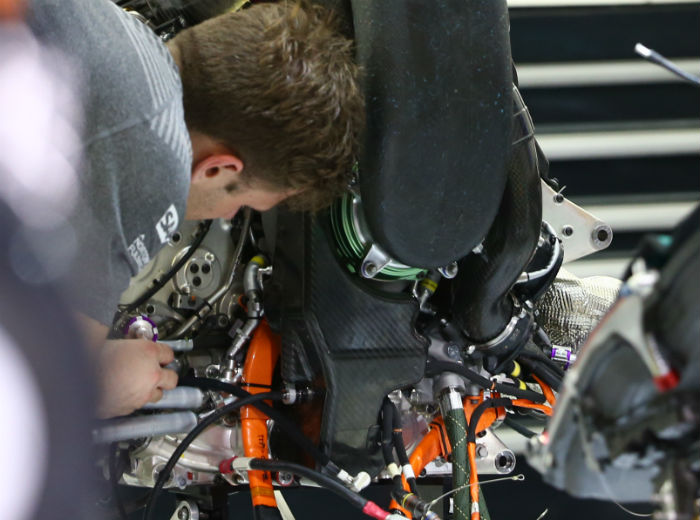
A look at the front end of the RA617H, the turbo-charger retains the split layout seen on the RA615H and RA616H. It is not clear if the compressor has been moved forwards. Note the orange high voltage electrical cables which reveal that the MGU-H remains in the V of the engine while the MGU-K sits on the left side of the crankcase.

